Impact of Generative Artificial Intelligence on Footwear Design Concept and Ideation †
Abstract
:1. Introduction
2. Literature Review
2.1. Defamiliarization
2.2. Design Thinking and Black Box
3. Method
3.1. Concept Ideation with Midjourney
3.2. Expert Evaluation
4. Results
4.1. Quantitative Analysis
4.2. Qualitative Analysis
5. Conclusions
Funding
Institutional Review Board Statement
Informed Consent Statement
Data Availability Statement
Conflicts of Interest
References
- Generative AI Could Raise Global GDP by 7%. Available online: https://www.goldmansachs.com/insights/pages/generative-ai-could-raise-global-gdp-by-7-percent.html (accessed on 19 July 2023).
- Feuerriegel, S.; Hartmann, J.; Janiesch, C.; Zschech, P. Generative AI. Bus. Inf. Syst. Eng. 2023, 1–16. [Google Scholar] [CrossRef]
- Boymamatovich, S.M. Exploring the Benefits and Future of Artificial Intelligence. Cent. Asian J. Theor. Appl. Sci. 2023, 4, 108–113. [Google Scholar]
- Hwang, G.J.; Chen, N.S. Editorial Position Paper: Exploring the Potential of Generative Artificial Intelligence in Education: Applications, Challenges, and Future Research Directions. Educ. Technol. Soc. 2023, 26, i–xviii. [Google Scholar]
- Huang, K.; Fu, T.; Gao, W.; Zhao, Y.; Roohani, Y.; Leskovec, J.; Coley, C.W.; Xiao, C.; Zitnik, M. Artificial intelligence foundation for therapeutic science. Nat. Chem. Biol. 2022, 18, 1033–1036. [Google Scholar] [CrossRef]
- Nesterenko, V.; Olefirenko, O. The impact of AI development on the development of marketing communications. Mark. Manag. Innov. 2023, 1, 169–181. [Google Scholar] [CrossRef]
- Wang, X.; Wang, D.; Chen, L.; Lin, Y. Building Transportation Foundation Model via Generative Graph Transformer. arXiv 2023, arXiv:2305.14826, 2023. [Google Scholar]
- Jaruga-Rozdolska, A. Artificial intelligence as part of future practices in the architect’s work: MidJourney generative tool as part of a process of creating an architectural form. Architectus 2022, 3, 95–104. [Google Scholar]
- Yan, H.; Zhang, H.; Liu, L.; Zhou, D.; Xu, X.; Zhang, Z.; Yan, S. Toward intelligent design: An ai-based fashion designer using generative adversarial networks aided by sketch and rendering generators. IEEE Trans. Multimed. 2023, 25, 2323–2338. [Google Scholar] [CrossRef]
- Fang, Y.M. The Role of Generative AI in Industrial Design: Enhancing the Design Process and Learning. In Proceedings of the IEEE conference proceedings: 2023 9th International Conference on Applied System Innovation (ICASI), Chiba, Japan, 21–25 April 2023. [Google Scholar]
- Vartiainen, H.; Tedre, M. Using artificial intelligence in craft education: Crafting with text-to-image generative models. Digit. Creat. 2023, 34, 1–21. [Google Scholar] [CrossRef]
- Curry, D. Artistic defamiliarization in the Age of Algorithmic prediction. Leonardo 2023, 56, 177–182. [Google Scholar] [CrossRef]
- Gunn, D.P. Making art strange: A commentary on defamiliarization. Ga. Rev. 1984, 38, 25–33. [Google Scholar]
- Shklovsky, V. Art as technique. In Contemporary Literary Criticism: Modernism through Poststructuralism; Con Davis, R., Ed.; Longman Press: New York, NY, USA; London, UK, 1986. [Google Scholar]
- Bell, G.; Blythe, M.; Sengers, P. Making by making strange: Defamiliarization and the design of domestic technologies. ACM Trans. Comput.-Hum. Interact. (TOCHI) 2005, 12, 149–173. [Google Scholar] [CrossRef]
- Cross, N. Research in Design Thinking. In Research in Design Thinking; Cross, N., Dorst, K., Roozenburg, N., Eds.; Delft University Press: Delft, The Netherlands, 1992; pp. 3–10. [Google Scholar]
- Gulari, M.N. Metaphors in design: How we think of design expertise. J. Res. Pract. 2015, 11, M8. [Google Scholar]
- Kochanowska, M.; Gagliardi, W.R. The double diamond model: In pursuit of simplicity and flexibility. In Perspectives on Design II: Research, Education and Practice; Raposo, D., Neves, J., Silva, J., Eds.; Springer: Cham, Switzerland, 2022; pp. 19–32. [Google Scholar]
- The Double Diamond. Available online: https://www.designcouncil.org.uk/our-resources/the-double-diamond/ (accessed on 19 July 2023).
- Design Counci, “History of the Double Diamond”. Available online: https://www.designcouncil.org.uk/our-resources/the-double-diamond/history-of-the-double-diamond/ (accessed on 19 July 2023).

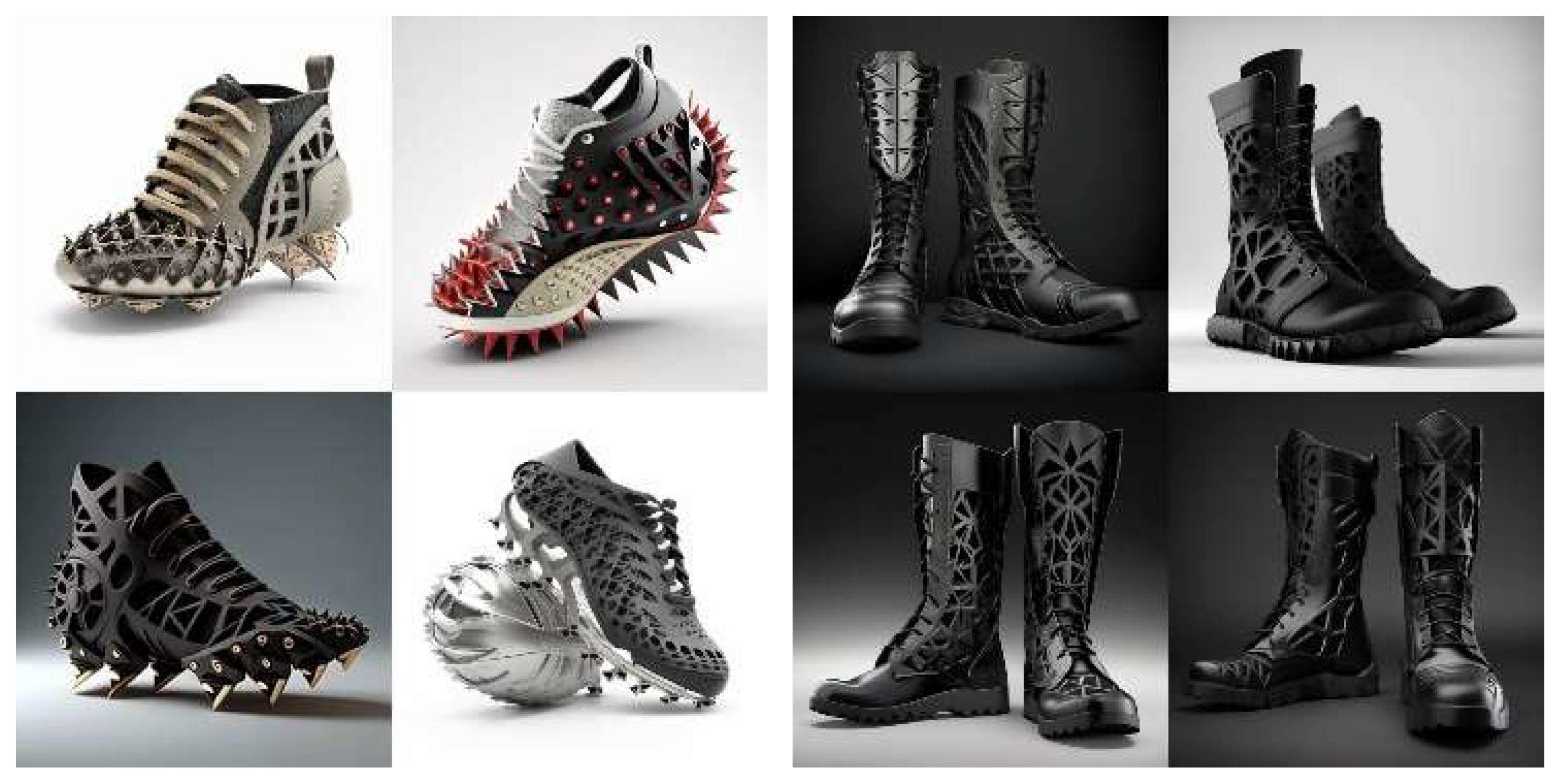
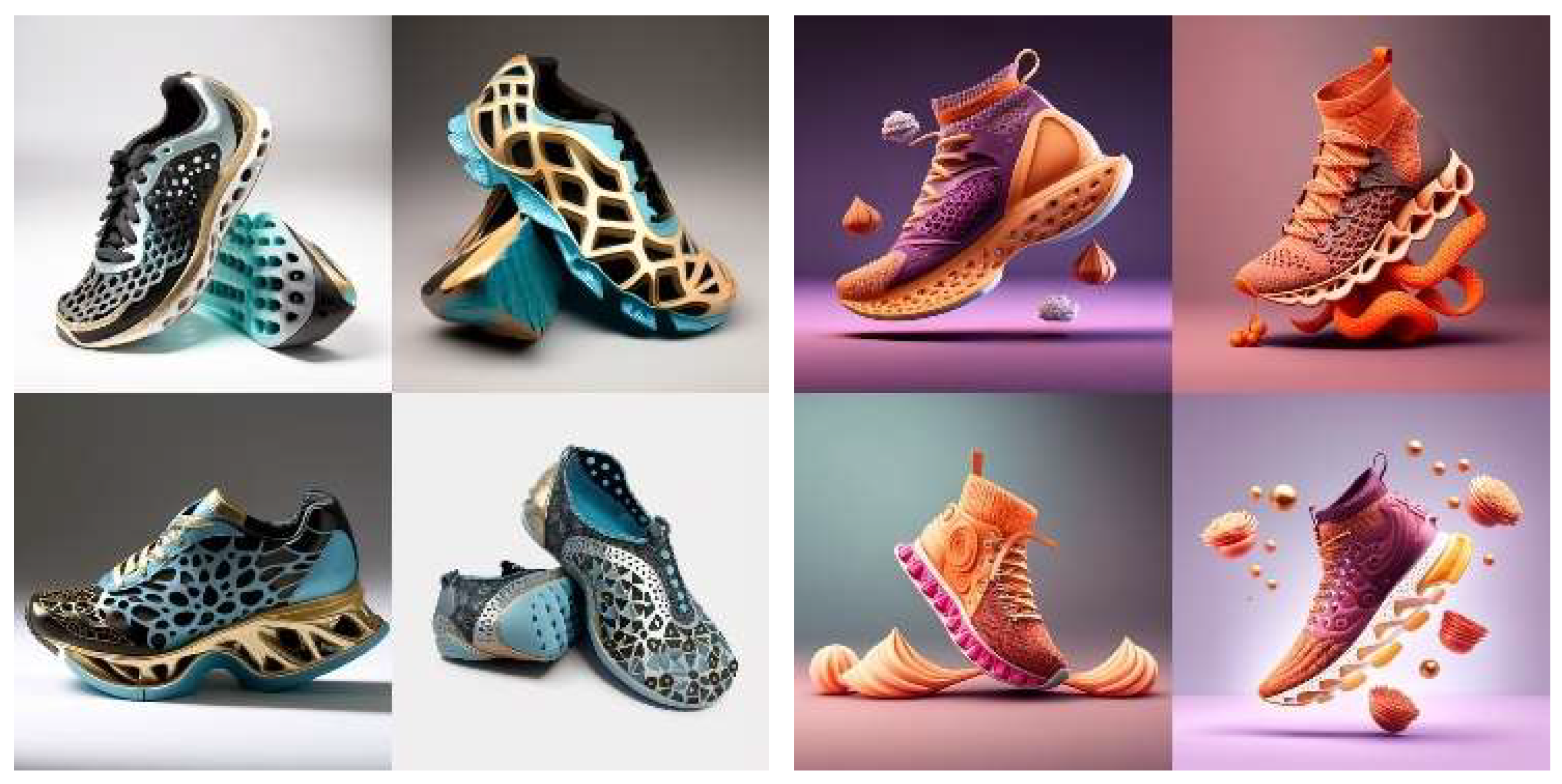
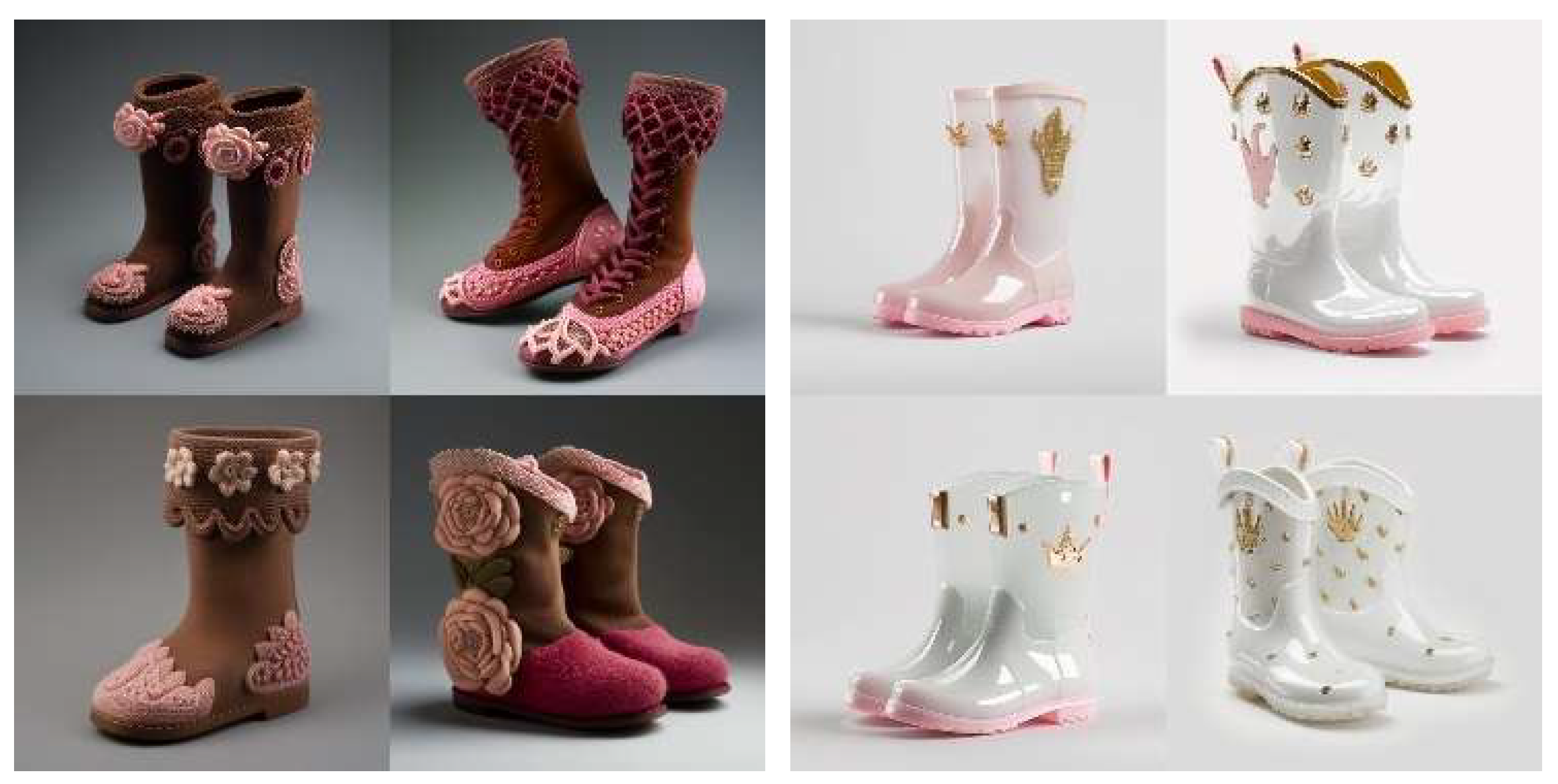
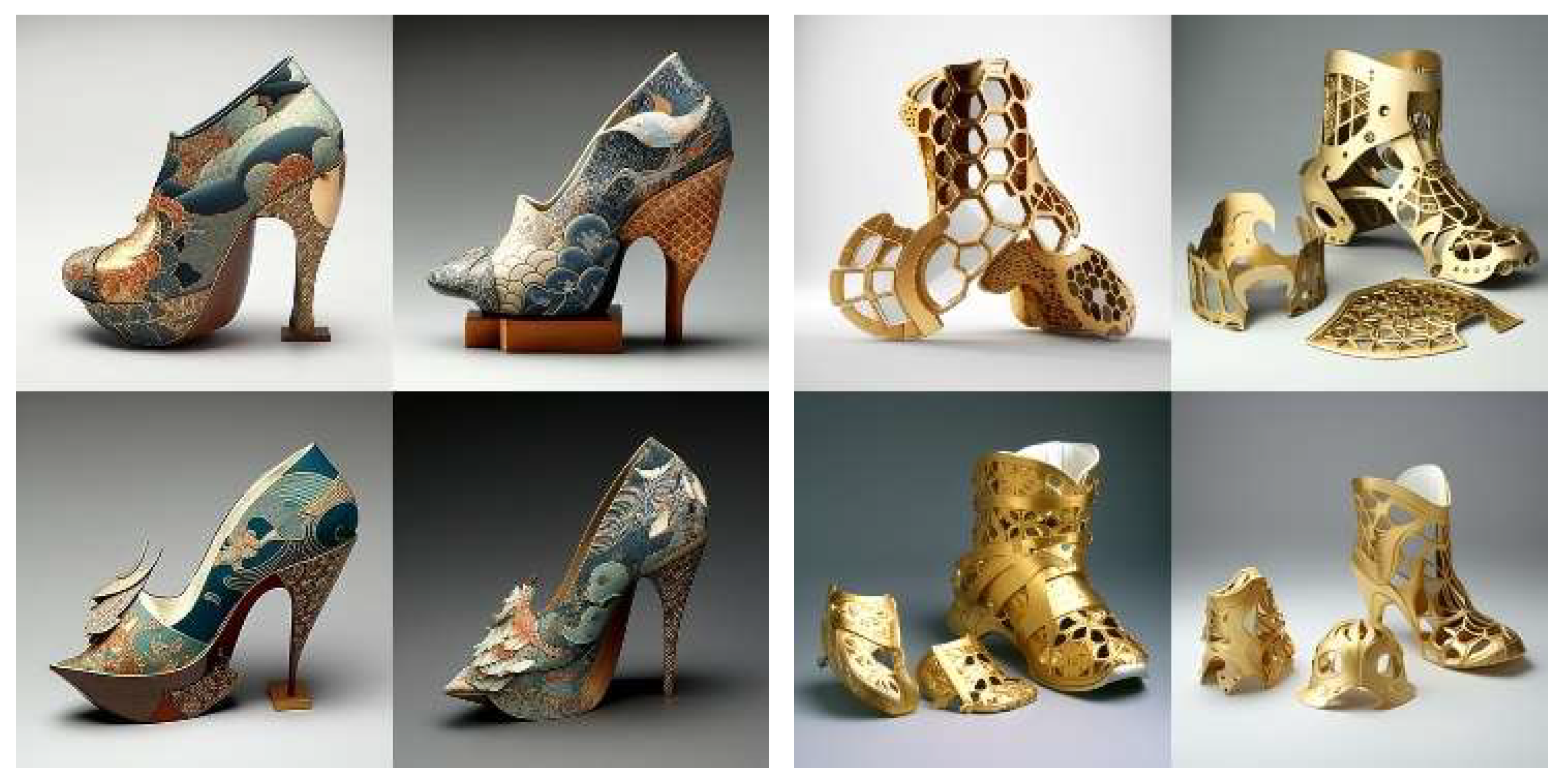
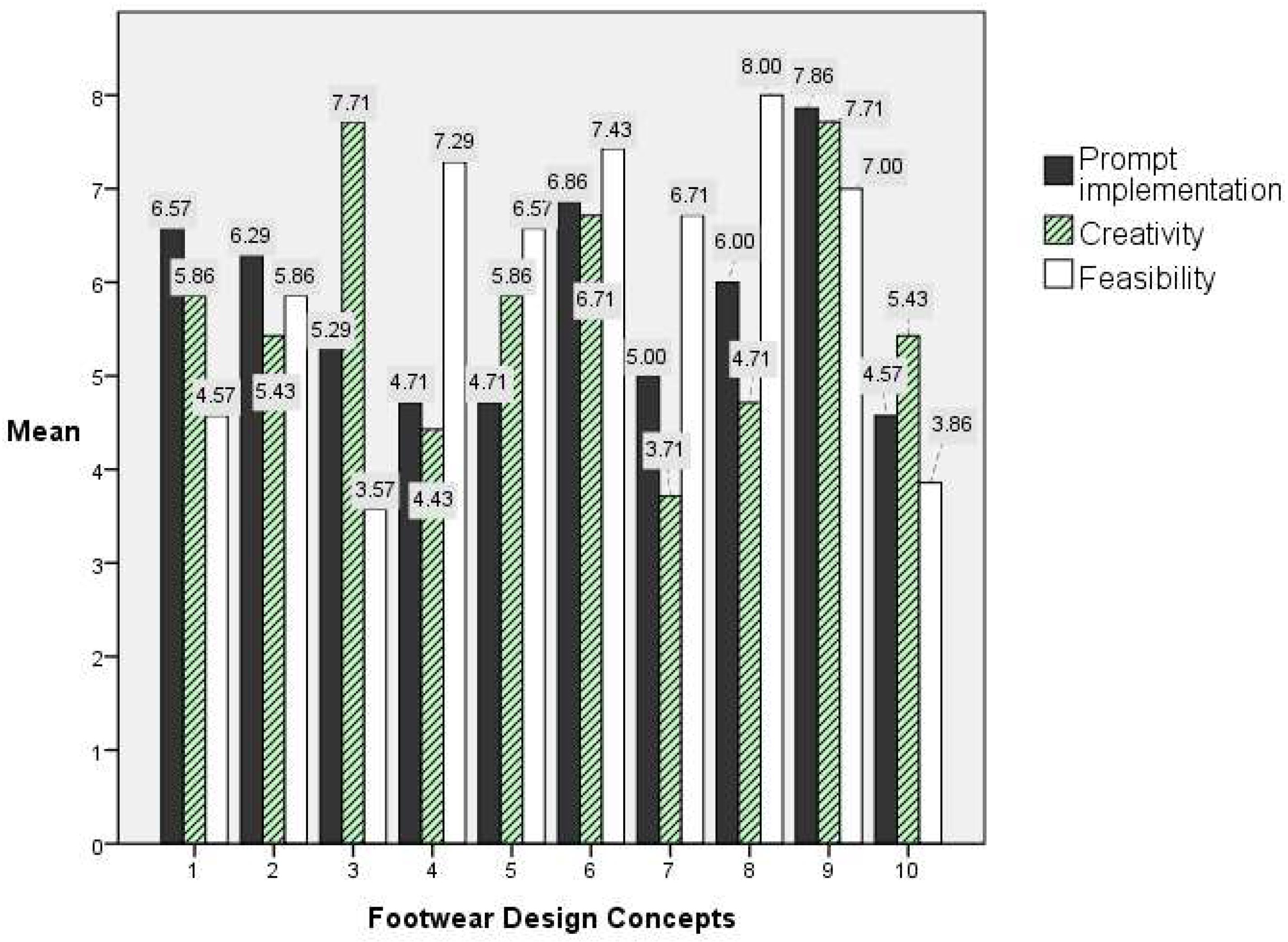
| No. | Subcategories (Image Style) | Word Count of Prompts |
|---|---|---|
| 1 | Soccer shoe (Chelsea style) | 10 |
| 2 | Women’s sporty sneaker (Futuristic style) | 15 |
| 3 | Football shoe (Mutation style) | 19 |
| 4 | Police tactical boots (Geometric Style) | 38 |
| 5 | Running shoe (Geometric Style) | 73 |
| 6 | Lady running shoes (Futuristic style) | 34 |
| 7 | Children’s shoes (Vivian Westwood style) | 59 |
| 8 | Children’s rain boots (Vivian Westwood style) | 54 |
| 9 | High-heeled shoes (Japanese kimono-style) | 45 |
| 10 | Protective devices for the feet (No style) | 220 |
| No. | Gender | Age | Years of Experience |
|---|---|---|---|
| E1 | Woman | 34 | 10 |
| E2 | Woman | 25 | 1 |
| E3 | Woman | 37 | 12 |
| E4 | Man | 35 | 6 |
| E5 | Woman | 30 | 7.5 |
| E6 | Woman | 23 | 1 |
| E7 | Woman | 27 | 1 |
| Expert | Ideation | Comments |
|---|---|---|
| E1 | 9th | I found this set of results to be highly artistic, with almost all the prompts successfully fulfilled, except for the generation of fish scales. |
| E4 | 9th | The Japanese style is evident in the presentation. |
| E5 | 9th | The implementation rate of prompts is not high, and many conditions interfere with each other. |
| E3 | 10th | The implementation rate of prompts is not high, and many conditions interfere with each other. |
| E5 | 10th | The settings and conditions in the prompts are specific and detailed, but GAI lacks integration capability, essentially only fulfilling the first two prompts. |
| Expert | Ideation | Comments |
|---|---|---|
| E1 | 9th | GAI doesn’t excel as much in the creativity of footwear design, perhaps because it analyzes big data using the shoe’s original stereotypes and archetypes to determine the shape the shoe should be. |
| E3 | 9th | GAI can combine difficult-to-imagine style features to generate designs rapidly. |
| E2 | 3rd | I find these computation results very innovative and creative! However, the design of this footwear makes it challenging to convey the elegance of women’s high-top shoes. |
| E2 | 4th | In terms of creativity, I believe these results are rather conservative, resembling the boots available in the market. Therefore, from a development standpoint, they seem quite reasonable. |
| E6 | 4th | These are relatively common among AI-generated results, but I believe they would be more widely accepted. Moreover, the development process should be easier compared to other results. |
| E4 | 7th | The prompts are more specific, resulting in a lower level of creativity. |
| Expert | Ideation | Comments |
|---|---|---|
| E6 | 8th | I personally find it quite attractive, and the development process shouldn’t be difficult either. This design has a certain charm that makes you want to buy it and keep it as a collectible. |
| E4 | 8th | The shiny polyethylene and transparent materials are presented reasonably. |
| E2 | 6th | Most sock-style sneakers tend to enhance the stability of the heel. In this set of results, I noticed that both the upper and the heel counter are supported by TPU or leather materials. |
| E5 | 10th | Regarding setting prompts, I recommend using no more than three design conditions for design generation and then using them as inspiration for the design. |
| E1 | 3rd | It has a visual impact but lacks consideration for wearability. |
| E4 | 3rd | It is challenging for GAI to simultaneously assess the practical feasibility of both materials and craftsmanship in the development process. |
Disclaimer/Publisher’s Note: The statements, opinions and data contained in all publications are solely those of the individual author(s) and contributor(s) and not of MDPI and/or the editor(s). MDPI and/or the editor(s) disclaim responsibility for any injury to people or property resulting from any ideas, methods, instructions or products referred to in the content. |
© 2023 by the author. Licensee MDPI, Basel, Switzerland. This article is an open access article distributed under the terms and conditions of the Creative Commons Attribution (CC BY) license (https://creativecommons.org/licenses/by/4.0/).
Share and Cite
Cheng, S.-H. Impact of Generative Artificial Intelligence on Footwear Design Concept and Ideation. Eng. Proc. 2023, 55, 32. https://doi.org/10.3390/engproc2023055032
Cheng S-H. Impact of Generative Artificial Intelligence on Footwear Design Concept and Ideation. Engineering Proceedings. 2023; 55(1):32. https://doi.org/10.3390/engproc2023055032
Chicago/Turabian StyleCheng, Shih-Hung. 2023. "Impact of Generative Artificial Intelligence on Footwear Design Concept and Ideation" Engineering Proceedings 55, no. 1: 32. https://doi.org/10.3390/engproc2023055032
APA StyleCheng, S.-H. (2023). Impact of Generative Artificial Intelligence on Footwear Design Concept and Ideation. Engineering Proceedings, 55(1), 32. https://doi.org/10.3390/engproc2023055032





